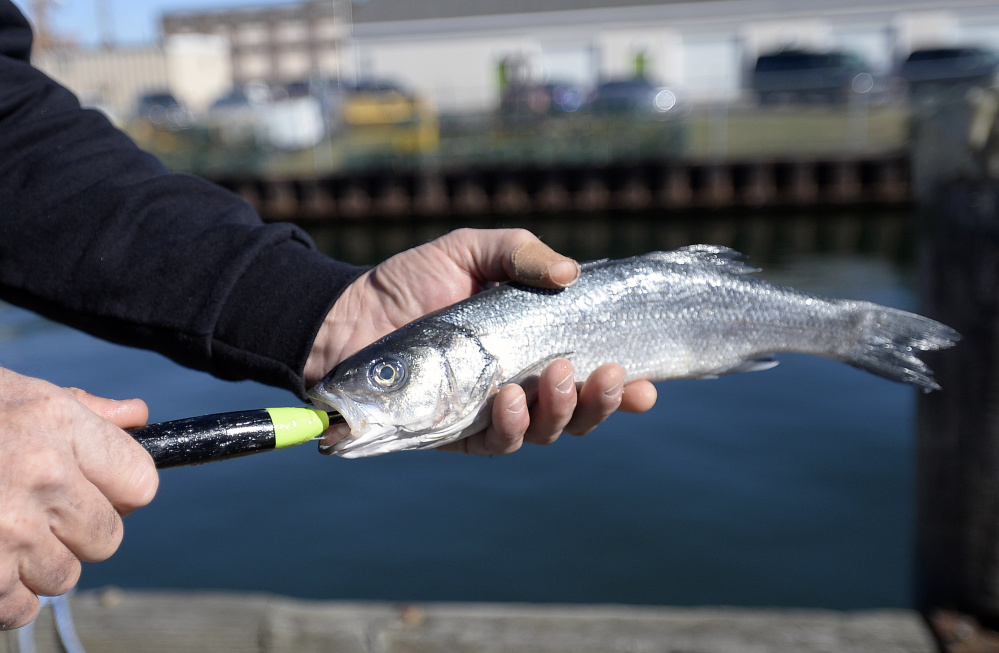A Maine inventor is making a splash in the big-game fishing community with a mechanical lure that brings bait fish back from the dead.
The product, appropriately named Zombait, is a hinged tube with a battery-powered motor inside that can be stuffed down the throat of dead bait to make it wiggle back and forth, simulating the swimming motion of a live fish. The idea is to trick big fish into thinking they’re going after live prey.
Zombait is the brain child of entrepreneur and veteran tuna fisherman Rink Varian, who lives in Phippsburg.
“This is the latest and greatest technology when it comes to the tackle box,” he said.
Varian dreamed up the idea for a lure that reanimates dead bait during a slow day of bluefin tuna fishing, which he attributed to a lack of live mackerel on his boat. He wondered if there might be a way to bring those dead mackerel “back to life.”
In 2014, Varian met up with an inventor friend to discuss the idea, and the friend put Varian in touch with his nephew, Massachusetts-based electrical engineer Matthew Borowski. Now the two are partners, along with mechanical engineer Jessy Cusack, who also lives in Massachusetts.
“Twenty-fourteen is when we first started to conceptualize and put some substance behind the idea,” Borowski said.

Rink Varian of Phippsburg, right, a fisherman, and Matthew Borowski of Massachusetts, a mechanical engineer, are two of the partners who developed Zombait, a battery-powered device that can be placed in dead bait fish, at top, to make it wiggle and be more attractive prey to bigger fish.
The development process for Zombait took over a year and involved several failed propotypes, he said. One was too big to fit in the bait fish’s mouth. Another wasn’t powerful enough to reanimate the fish. Other early prototypes weren’t waterproof and couldn’t withstand the pressure of being used and reused in deep water.
After many iterations, the team finally was able to produce a version of Zombait that was small, powerful, waterproof and durable, Borowski said. In late 2015, they launched a crowdfunding campaign on Kickstarter, which raised nearly $30,000 in 45 days to fund the product’s initial production run of 1,000 units.
The initial run sold out quickly, Borowski said. The company, called Magurobotics LLC (“maguro” is the Japanese word for bluefin tuna), is about to complete a second production run of 3,000 units, which it is selling through the website Zombait.com.
Borowski said Magurobotics hopes to attract investors and eventually sell Zombait lures on Amazon.com and through brick-and-mortar retailers. The startup is scheduled to appear this week on the CNBC show “Adventure Capitalists,” an entrepreneur pitch show like “Shark Tank,” but strictly for “outdoor adventure” products.
Varian said he has used Zombait to catch a wide variety of big fish, including tuna, grouper and striped bass.
“We find that it works on all kinds of species of fish,” he said.
Zombait customer Dave Marciano of the commercial fishing vessel Hard Merchandise said nothing beats live bait for catching big fish, but that Zombait is a good product to use when live bait isn’t available.
Marciano, a fisherman based in Gloucester, Massachusetts, who was featured on the National Geographic Channel reality TV series “Wicked Tuna,” called Zombait “a neat little idea” that makes a good addition to the fisherman’s toolbox.
“You can’t always get live bait,” he said. “I thought it was a really good idea to give some sort of life to dead bait.”
Most commercial fishing boats are equipped with live bait tanks, Varian said, but many sport fishermen don’t have an easy way to maintain a stock of live bait. Those are the customers to whom Zombait is designed to appeal.
The product, which currently sells for $69 apiece or three for $159, comes with swappable, rechargeable batteries that last about three hours on a full charge. Each lure has a hole on one end that is used to tether it to the fisherman’s line for easy retrieval.
Borowski said users simply tie Zombait to their line, insert it into the bait fish’s mouth, and then attach the fish to their hook like they normally would. Zombait tends to pop out of the bait fish when a big fish bites, and it ends up coming out of the water dangling alongside the fisherman’s catch.

Fishermen use the Zombait device by tying it to their line, inserting it into the dead bait fish’s mouth and then attaching the fish to their hook like they normally would. Zombait is made for when live bait is not available.
The product has been tested for depths up to 200 feet, he said.
Varian said he has been using the same three Zombait lures all season, and that all of them have held up without breaking.
“The plastics in those things are the same plastics they use in NFL football helmets,” he said.
J. Craig Anderson can be contacted at 791-6390 or at:
Twitter: jcraiganderson
Copy the Story LinkSend questions/comments to the editors.




Success. Please wait for the page to reload. If the page does not reload within 5 seconds, please refresh the page.
Enter your email and password to access comments.
Hi, to comment on stories you must . This profile is in addition to your subscription and website login.
Already have a commenting profile? .
Invalid username/password.
Please check your email to confirm and complete your registration.
Only subscribers are eligible to post comments. Please subscribe or login first for digital access. Here’s why.
Use the form below to reset your password. When you've submitted your account email, we will send an email with a reset code.